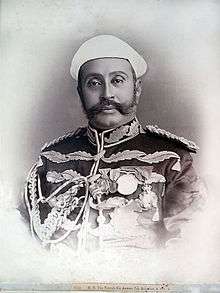Asman Jah
Nawab Sir Muhammad Mazharuddin Khan Bahadur KCIE (1839 – 18 July 1898), commonly known as Sir Asman Jah or Nawab Sir Asman Jah Bahadur, was an Indian noble who served as Prime Minister of Hyderabad from 1887 to 1894. A member of the powerful Paigah family, Asman Jah built the Asman Garh Palace, Basheer Bagh Palace, and Mahboob Chowk Clock Tower. He represented Nizam Mahbub Ali Khan at the Golden Jubilee of Queen Victoria.
Asman Jah Bahadur KCIE | |
|---|---|
 | |
| 28th Prime Minister of Hyderabad | |
| In office 1887–1894 | |
| Monarch | Mahbub Ali Khan |
| Governor General | The Earl of Dufferin The Marquess of Lansdowne |
| Preceded by | Salar Jung II |
| Succeeded by | Viqar-ul-Umra |
| Personal details | |
| Born | Muhammad Mazharuddin Khan 1839 |
| Died | 18 July 1898 (aged 58–59) Basheer Bagh Palace, Hyderabad, Hyderabad State (present-day Telangana, India) |
| Resting place | Paigah Tombs |
| Spouse(s) | Parwarishunnisa Begum |
| Children | Muinuddin Khan |
| Relatives | Viqar-ul-Umra (cousin) Mahbub Ali Khan (brother-in-law) Afzal-ud-Daulah (father-in-law) |
Early life and ancestry
Asman Jah was born as Mazharuddin Khan in 1839, although his exact date of birth is not recorded. His biological father Sultanuddin Khan was the third son of Fakhruddin Khan. After Sultanuddin's death, Asman Jah was adopted by his uncle Rafiuddin Khan Shams-ul-Umra III. Jah's maternal grandmother was Bashirunnisa Begum, a daughter of Nizam Nizam Ali Khan.[1][2]
Asman Jah was a member of the noble Paigah family which was hierarchically second to the Nizam of Hyderabad. The members of the family were staunch Nizam loyalists.[3] The family descends from the Second Rashidun caliph Umar(R.A) Sufi saint Fariduddin Ganjshakar is also an ancestor of the family. One of Jah's ancestor Muhammad Abu’l Khair Khan was a mansabdar during Mughal emperor Aurangzeb's reign. Jah's cousin Viqar-ul-Umra also served as Prime Minister of Hyderabad.
Political career
In 1869, Asman Jah was appointed as Minister for Justice and served in that position until 1888. After the death of Sir Salar Jung I in 1883, Jah was made a member of the Council of Regency. He also went on to become the administrator of the Hyderabad State during the Nizam's visit to Kolkata during the same year.[1]
In 1887, Nizam Mahbub Ali Khan chose Jah to represent him at the Golden Jubilee celebration of Queen Victoria held at the Windsor Castle. After returning from England, he was appointed Prime Minister of the state.[1] He was replaced by his cousin Viqar-ul-Umra in 1894.[4]
Architecture
Jah built the Mahboob Chowk Clock Tower in 1892. The clock tower had clocks on its four sides and was constructed in the middle of a garden.[5] He also built the Basheer Bagh Palace at a cost of about ₹400,000 (US$5,600) in c. 1880.[6] Jah also constructed the Asman Garh Palace in 1885 at the top of a hillock in Hyderabad. It was built in the Gothic architecture style and had pointed arches supported by Corinthian pillars. Jah's brother-in-law and Nizam Mahbub Ali Khan enjoyed living in the palace and he later gifted it to the Nizam. The building presently houses the St. Joseph’s Public School.[6][7]
Personal life
Jah was married to Parwarishunnisa Begum, the daughter of the fifth Nizam Tahniyath Ali Khan.[8] They had one son Muinuddin Khan who was born in 1891. Jah died at Basheer Bagh Palace on 16 July 1898 and is buried at Paigah Tombs.[9] Jah brought up cricketer Syed Mohammad Hadi after his father died. Hadi scored the first-ever century in the Ranji Trophy.[10]
Asman Jah's full name with titles is Asman Jah, Amir-i-Akbar, Azam-ul-Umra, Umdat-ul-Mulk, Bashir-ud-Daulah, Nawab Sir Muhammad Mazharuddin Khan Bahadur, Rifat Jung KCIE.[1]
References
- Lethbridge 2005, p. 31.
- Lynton 1992, p. 86.
- Safvi, Rana (21 January 2018). "The Paigah's necropolis". The Hindu. Retrieved 30 March 2019.
- Lethbridge 2005, p. 32.
- "After decades of neglect, Hyd's 126-year-old Mahboob Chowk clock starts ticking again". The News Minute. 1 October 2018. Retrieved 30 March 2019.
- Verma, Anand Raj (14 January 2018). "Palaces lost in time". Telangana Today. Retrieved 30 March 2019.
- "Castle of dreams". The Hindu. 21 January 2004. Retrieved 30 March 2019.
- Shehbaz Safrani (1992). Golconda and Hyderabad. Marg Publications. p. 131. ISBN 9788185026190.
- Verma, Anand Raj (26 November 2017). "The resplendent Paigah tombs". Telangana Today. Retrieved 30 March 2019.
- Dhole, Pradip (14 June 2016). "Syed Mohammad 'Rainbow' Hadi: First man to score a Ranji Trophy hundred". Cricket Country. Retrieved 27 September 2018.
Sources
- Lynton, Harriet Ronken (1992), Days Of The Beloved, Orient Blackswan, ISBN 9780863112690
- Lethbridge, Roper (2005), The Golden Book of India: A Genealogical and Biographical Dictionary of the Ruling Princes, Chiefs, Nobles, and Other Personages, Titled Or Decorated of the Indian Empire, Aakar Books, ISBN 9788187879541
External links
| Government offices | ||
|---|---|---|
| Preceded by Salar Jung II |
Prime Minister of Hyderabad 1887–1893 |
Succeeded by Sir Vicar-ul-Umra |